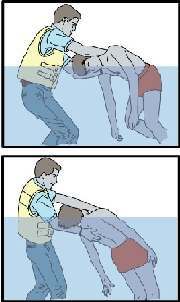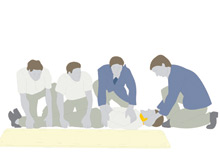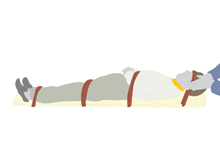Every day, at least one South African suffers a serious neck or back injury. Some will never be able to walk again; others will lose the use of their arms as well as their legs.
Yet fast, competent first aid administered at the scene of an accident can give an injured person a much greater chance of recovery.
What happens in the first hour after a neck or back injury can be all-important: it can mean the difference between paralysis and full use of the limbs, or between life and death.
Why? A neck or back injury often causes swelling. If this swelling isn’t relieved quickly it could cause permanent damage to the spinal cord and nerves – and lead to paralysis of the arms and legs. An accident or injury can also result in almost instantaneous irreparable damage if the spinal column is hurt.
Important: Keep the person as still as possible if you suspect a neck or back injury.
The smallest movement of a damaged spine can cause permanent paralysis and even death.
Look for these signs of a neck or spinal injury:
- A stiff neck and back, or neck and back pain
- Unusual neck or back position
- Headache
- A tingling sensation, numbness or weakness in the hands and feet
- Poor or no bladder control
- Breathing difficulty
- Contusions on the head, neck, shoulders or back
- Partial consciousness or complete unconsciousness
A: After a diving accident in a swimming pool, shallow water, dam, river or the sea
- If you suspect someone has hurt his neck after diving into a sandbank or shallow water, don't try to pull him out of the water.
- If he's face-up in the water, keep him as still as possible until help arrives. Make sure his nose and mouth are above water without bending or snapping the neck and keep the head as still as you can. Make sure he's not swallowing water and can breathe. The water will support the injured back and keep it stable.
-
If he's lying face-down turn him over without bending or snapping the neck. Get two other people to help you. One helper must support the head while the other two turn the injured person on his back in a single, controlled motion. Never turn the head sideways without also turning the rest of the body. All three lifesavers should work together on the count of three.
- Once the injured person is face-up, breathing and not in a life-threatening situation in dangerous water it's best to keep him as still as possible. Wait for paramedics to arrive so they can stabilise the spine with the correct equipment before the victim is removed from the water.
- Remove the injured person from the water only if he can't breathe or if you can't detect a pulse in the neck. In that case drag him from the water while keeping the head and spine aligned as far as possible, without bending or snapping the neck. Place him flat on the ground and apply CPR.
B: After a neck or back injury on the sports field
- Check to see if his airways are clear and whether he's breathing by holding your ear close to his nose while looking to see if his chest is moving up and down.
- If he's breathing, check if he can speak. If he can, ask if he has any back or neck pain or numbness or weakness in the limbs.
- If he can't breathe or speak, don't touch him – leave him in the same position until an ambulance arrives.
- If he's not breathing and you can't detect a pulse you must apply CPR. To do this you'll need two or three people to help you turn the injured person onto his back. One should hold the head in such a way that the head and body can be turned in one controlled movement without the neck bending in any way. Then apply CPR without removing any protective headgear the person may be wearing.
- Stabilise the head and neck while waiting for paramedics to arrive.
C: After a road accident
Follow the steps in section B if you suspect an injured pedestrian, cyclist or passenger has a neck or back injury. Move the injured person only if he's in life-threatening danger. If you're alone and have to act fast pull the person to safety by the shoulders, at the same time using your forearms to prevent the neck from bending.
How to roll an injured person onto a stretcher without hurting his neck
-
Get two or three people to help you. While one of you supports the injured person's neck the others can help turn him. Use a neck brace if you have one.
-
Move the injured person's head, neck and shoulders as a unit. Work together on the count of three.
-
With a single movement turn the person on his side and move the stretcher close to his back.
-
Roll him back on the stretcher. Secure the victim and make sure his neck is in a stable position.
NOTE: DON’T give an injured person anything to eat or drink, even if he asks.
Read more:
(This article was originally published in the autumn edition of YOU Pulse magazine in March 2008.)




 Publications
Publications
 Partners
Partners














